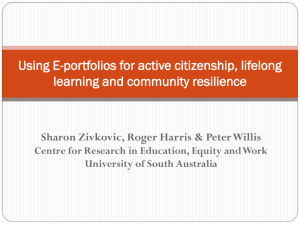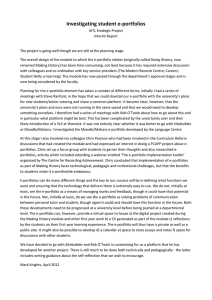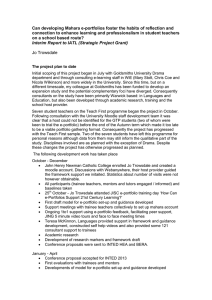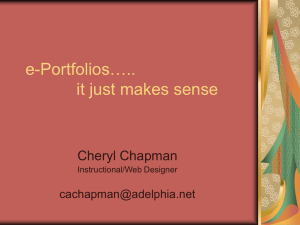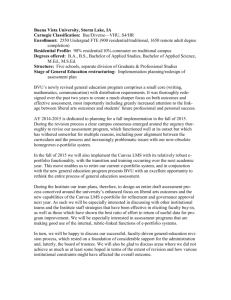Final Report by Prof Mark Knights
advertisement
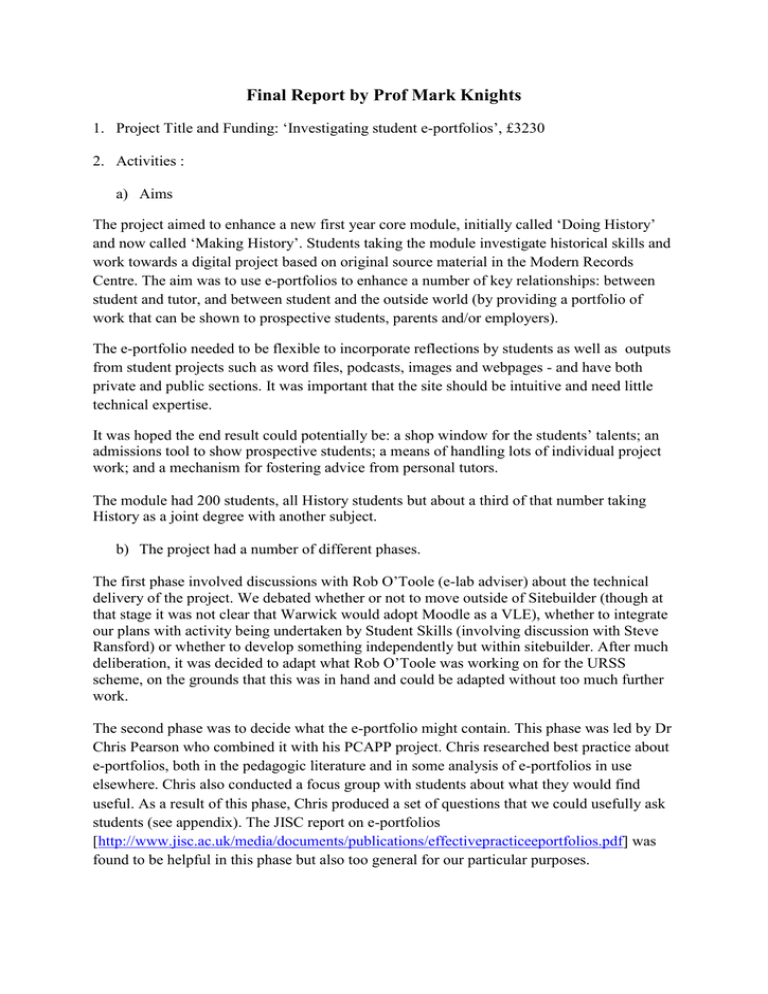
Final Report by Prof Mark Knights 1. Project Title and Funding: ‘Investigating student e-portfolios’, £3230 2. Activities : a) Aims The project aimed to enhance a new first year core module, initially called ‘Doing History’ and now called ‘Making History’. Students taking the module investigate historical skills and work towards a digital project based on original source material in the Modern Records Centre. The aim was to use e-portfolios to enhance a number of key relationships: between student and tutor, and between student and the outside world (by providing a portfolio of work that can be shown to prospective students, parents and/or employers). The e-portfolio needed to be flexible to incorporate reflections by students as well as outputs from student projects such as word files, podcasts, images and webpages - and have both private and public sections. It was important that the site should be intuitive and need little technical expertise. It was hoped the end result could potentially be: a shop window for the students’ talents; an admissions tool to show prospective students; a means of handling lots of individual project work; and a mechanism for fostering advice from personal tutors. The module had 200 students, all History students but about a third of that number taking History as a joint degree with another subject. b) The project had a number of different phases. The first phase involved discussions with Rob O’Toole (e-lab adviser) about the technical delivery of the project. We debated whether or not to move outside of Sitebuilder (though at that stage it was not clear that Warwick would adopt Moodle as a VLE), whether to integrate our plans with activity being undertaken by Student Skills (involving discussion with Steve Ransford) or whether to develop something independently but within sitebuilder. After much deliberation, it was decided to adapt what Rob O’Toole was working on for the URSS scheme, on the grounds that this was in hand and could be adapted without too much further work. The second phase was to decide what the e-portfolio might contain. This phase was led by Dr Chris Pearson who combined it with his PCAPP project. Chris researched best practice about e-portfolios, both in the pedagogic literature and in some analysis of e-portfolios in use elsewhere. Chris also conducted a focus group with students about what they would find useful. As a result of this phase, Chris produced a set of questions that we could usefully ask students (see appendix). The JISC report on e-portfolios [http://www.jisc.ac.uk/media/documents/publications/effectivepracticeeportfolios.pdf] was found to be helpful in this phase but also too general for our particular purposes. A third phase involved discussions with the Language Centre which had experimented with Moodle and also offered the possibility of integrating certificates for languages taken by our students into an e-portfolio. In the end, these discussions did not come to anything because of the different platform being used by the Language Centre, their different timetable for the delivery of certification and the History department’s decision to remove language as a compulsory element of the degree programme. The fourth phase of the project was the development of the Making History module website and its integration with the platform devised by Rob O’Toole. This was rather fraught since the platform was not ready at the beginning of the academic year and had to be incorporated into the module in the first few weeks of term, without adequate testing. That said, the platform achieved most of the essential functions required of it and was relatively intuitive. The fifth phase of the project was the students’ use of the site, during reading week of term 1 2012/13. This did throw up some technical teething issues but most of these were resolved quickly. The students’ take-up of the e-portfolio was rather patchy, with some students needing quite a bit of encouragement to complete the feedback, whilst others took to it very readily and, perhaps as a result of experience with social media, were candid and open in their comments. This data provided us with unprecedented amounts of data about how students felt about the module – what they found enjoyable and what they thought could be improved. It became clear, for example, that there was some overlap with work done at A level, with the result that we were able to decide on revisions to the module for the following year. We also learned that joint-degree students found the module much more challenging than single-honour students. Sociologists, for example, were relatively unused to working in the archives and therefore needed more convincing about the relevance of the module to their degree programme. We also learned how appreciative students were of their seminar tutors, for whom there was almost universal praise. The e-portfolio thus allowed the department to gain an unrivalled insight into the first year student body, at an early stage in their Warwick careers. The e-portfolios proved to be of significant use to tutors, though some liked it more than others. It was undoubtedly more work – another ‘thing to do’ – but tutors reported that it gave them valuable feedback, particularly on students who were quietest in seminars but who opened up on-line. Students were encouraged to be self-critical and that also helped tutors learn about individuals’ objectives. Further stages of the e-portfolio are planned but not yet delivered. Students will use the platform to upload digital projects in term 3 and we shall then have to decide how much of the material to open to the public. Students also had a careers session at the end of term 2 and will be encouraged to place their CVs on their e-portfolios. Given the university-wide introduction of the online assessment system, the department will need to consider how to make the e-portfolio compatible, so that students have a single point of entry into both systems. The university’s decision to establish some sort of on-line personal tutor system will also need to be reconciled, so that information is not duplicated. The e-portfolios can be accessed from http://www2.warwick.ac.uk/fac/arts/history/undergraduate/modules/makinghistory/eportfolios/ though the pages are closed and permission will be needed to view them. 3. Outcomes As this suggests, the project is still on-going, so a final evaluation is not yet possible. However so far the advantages have been: Unprecedented amounts of information about student attitudes and needs, that has helped us revise the outline of the module for next academic year much earlier than might otherwise have been possible and helped tutors identify strengths and weaknesses of individual students. The data enabled fine-grained analysis of what was going well and what needed more attention. This has been particularly useful for the first run of a core module. Establishing a good means of communication with our students, enhancing the experience of SSLCs and module feedback forms. Encouragement of students to reflect on their learning experience from an early stage in their career The establishment of a platform that they can continue to use throughout their career. The disadvantages have been or are: Patchy take-up by students – some students clearly found it very useful but others have been very reluctant to undertake the exercise (some citing the fact that it is not part of any formal assessment). It might be that a second term reflective exercise is less useful than the first and final term work. The danger of proliferation of sites relating to the learning experience, with onlineassessment and personal tutoring systems that should be integrated into a single platform with the e-portfolio. The department is not yet decided about the longer-term future of the e-portfolio – much will depend on the success or otherwise of the term 3 project uploading and display. Even if the eportfolio is retained, the issue of integration with other on-line elements of the student learning experience does need to be addressed and we have begun active discussion about this with Rob O’Toole. If the e-portfolio could become embedded in the Tabula system, so that students had a single entry point, then this could have great potential and also mean that other departments would have a powerful tool at their disposal. In the meantime, retaining some element of the e-portfolio experiment seem justified, even if some of its original ambitious scope might need to be curtailed. Further information about the project can be obtained from Prof Mark Knights [m.j.knights@warwick.ac.uk] Appendix: History Department E-portfolio focus group summary This focus group was organized by Dr Chris Pearson as part of his Postgraduate Certificate in Academic and Professional Practice. It took place on 1 March 2012. Its aim was to obtain student opinions and feedback on e-learning and e-portfolios to inform the introduction of eportfolios within the History Department’s new first year module Making History, which will come online in October 2012. The department’s e-portfolio implementation project is supported by funding from Warwick’s Institute for Advanced Teaching and Learning. The focus group took place after consultation with Professor Mark Knights, the convenor of Making History. Six students took part in the focus group, selected from across the year groups and from the History, History and Politics, and History and Sociology degrees. This document summarizes the content of the focus group. Participants’ comments have been made anonymous. During the focus group, participants expressed their concerns that Making History, the module in which e-portfolios will sit, would reduce optionality for joint honours students. Important points were raised, which the department is aware of through the SSLC, TALCOM and other communications with students. But as these comments on optionality did not relate directly to e-portfolios I will not record them here. General use of IT during the History degree To start with, participants were asked to outline what kinds of IT they had used during the course of their degree. The responses were: Jstor, Google Books, Google Scholar, Wikipedia, word processing packages, the library catalogue, powerpoint, digitized primary sources, email, electronic timetables, digitized seminar readings, and podcasts. One had used eportfolios with the Moodle Virtual Learning Environment as part of their studies in the Language Centre. There was also some familiarity with referencing software (Endnote?) and Structure View (?) within Word. Some of their lecturers used powerpoint, which could be helpful, depending on their lecturing style. Although none of the students wrote blogs, they saw blogs written by academics as a way of bridging the gap between staff and students. They had used Facebook to interact with fellow members of their MMW group presentation team and with History Society mentors. One student used Twitter to keep abreast of news and what was going on within the University and would welcome a departmental Twitter account as a way of keeping in touch with the department (they said that they would pay more attention to tweets than email). They found helpful the Politics Department’s use of Twitter as a way of reminding students about deadlines. On the whole, participants felt that science students had more use for IT than history students and economic historians had greater need for IT than social historians. The department should therefore not encourage IT for the sake of it but link it to the content and context of the History degree. Another key point is that the department and university should make the use of IT easy (unlike MyAdvantage and Mahara e-portfolios which are unclear and hard to use). Moreover, tutors needed to know how to use the software to support students’ use of it, particularly for those students who lacked confidence in using IT. There was recognition that IT skills were becoming more important for everyone. Law firms looked to recruit employees with IT literacy and advertisers and publishers want staff to have familiarity with graphics programmes. Even employers such as the Warwick Arts Centre gallery enquired about social media during interviews. E-portfolios Students were asked for their views on e-portfolios. The student who had used Mahara described it as an ‘irritating hindrance’ to learning because it was too complicated and tutors did not know how to use it. But if e-portfolios were easier to use, they could be a useful thing. They have potential. Some participants found that they forgot their essay marks and that it would be useful to have their essays stored in one place (which would be possible on the e-portfolio). They also said that they would welcome online feedback from tutors via the e-portfolio. It would be helpful if the feedback, and particularly the comments on how to improve essays, could be stored online so that it would be readily consultable when the time came to write future essays. Module feedback could also be given via e-portfolios. They also felt that e-portfolios could be a productive way of showing others (family, friends etc) their interest in history, as well as showing their work to potential employers. That said, participants stressed that they wanted control over what sections of the e-portfolio would be made public. In terms of using e-portfolios as a way of encouraging reflective learning, some participants felt that prompt questions with tick box answers would be helpful. One student, however, wanted space for longer reflections. It was agreed that a mixture of tick boxes and larger text boxes would be a good way to proceed. At least one participant felt that the Department should make the use of e-portfolios compulsory otherwise students may not use them. It should also make it clear that the eportfolio is an academic tool; it should assess students on the academic content of the eportfolio rather than their use of technology. The features participants wanted to see in the e-portfolio include: - Space to store essays Feedback from tutors A log for the MMW group project Space to note down books/articles/ideas that they found useful and wanted to return to over the course of their degree A way of setting up groups and links with other students. This social media element could allow students to share lecture notes, information amongst seminar group members, - ask questions of other students, and follow students interested in similar areas. This should be strictly academic as opposed to the more personal character of Facebook. A “What’s On” calendar A private space for reflection (which might be shared with the student’s personal tutor if appropriate) The possibility of uploading a photograph and CV to the public part of the e-portfolio, although this should not be compulsory. Blogs/podcasts/Wikis – again, the individual student should choose whether or not these would be made public. Participants saw the challenges of implementing e-portfolios as: - - Getting students to use them – the Department would need to incentivize their use, perhaps through making it compulsory (although there was some concern that this would undermine the e-portfolios) Keeping the technology simple Linking them up to other online interfaces with the department -e.g. submitting essays through the e-portfolio instead of e-submission Making sure that staff knew how to use the technology so that they would be in a position to support students Questions to be asked: Term 1 In what ways is the study of history at university different from the study of history at school? What are you enjoying most about studying history at university? What do you find most difficult? Do you know where to access academic and/or pastoral support? If not, please see your personal tutor. Thinking back to the sources that you’ve studied so far on this module, which one do you find the most interesting and why? Term 2 Thinking back to the sources that you’ve studied so far on this module, which one do you find the most interesting and why? Is this different from the source you identified in term 1? In terms of study skills, what are you strengths and weaknesses? If there are any areas that you feel need more work, you may wish to ask your module tutor or personal tutor for advice. How do you feel about your exam performance? In what ways can you use your exam feedback in future exams? In what ways, if any, have your ideas about what constitutes history changed over the course of this module? NB These questions were replaced, in the light of feedback from term 1, with the following: - Was the Making History exam what you expected and what did you learn from it? (end week 3) - Have you found any areas of overlap with topics or approaches from school and if so, what were they? (end of week 5) - Write 100-200 words on the topic that you would like to choose for your Third Term MRC project. (end of week 7)
